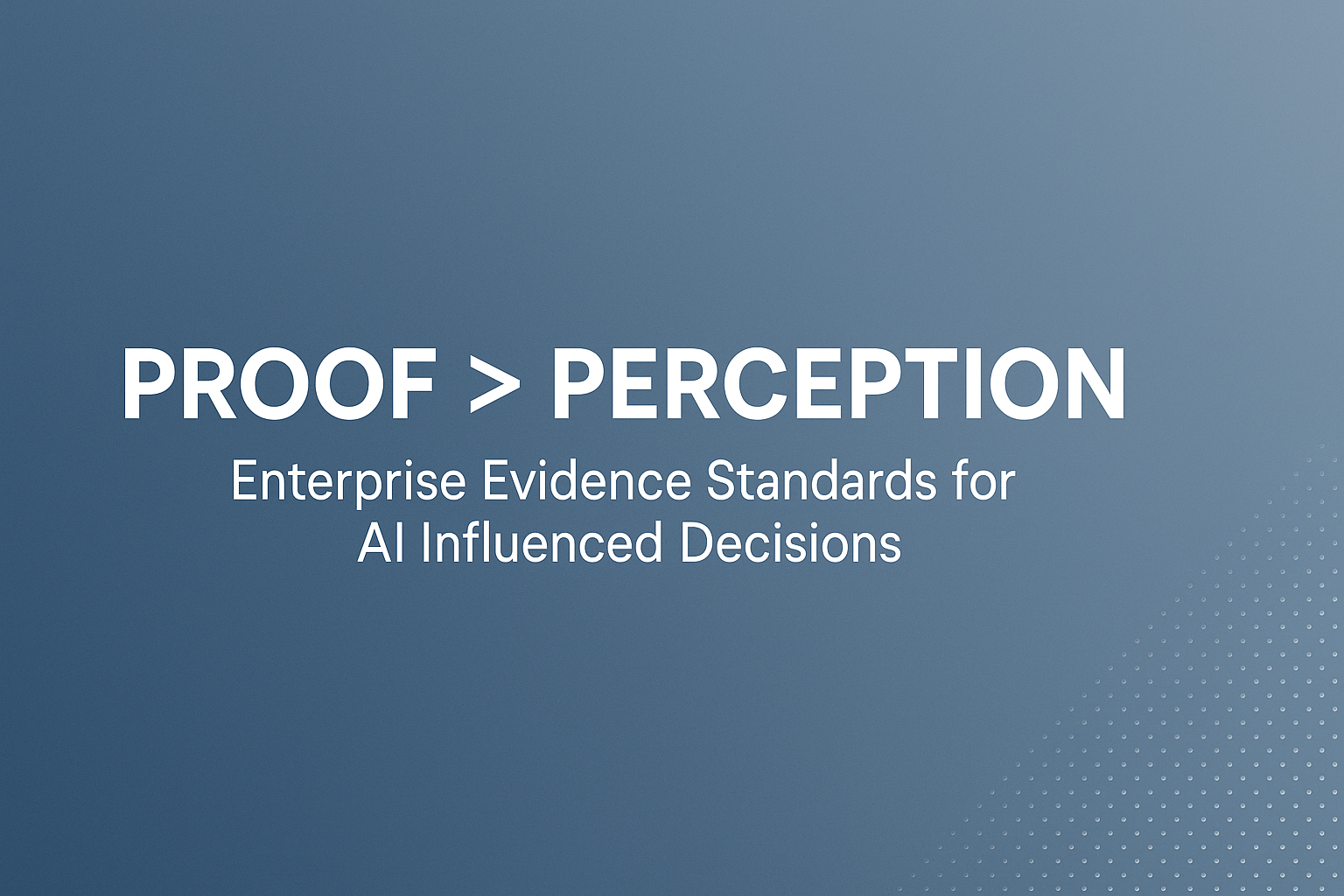Proof > Perception: Enterprise Evidence Standards for AI Influenced Decisions

Enterprises are moving past experimentation with AI. The central question has shifted. It is no longer whether AI can generate insight. It is whether those insights can withstand internal audit review and external scrutiny when they inform board materials, earnings language, strategy models, and policy decisions.
Perception is insufficient in that context. Proof becomes mandatory once AI outputs influence governance surfaces.
AI assistance introduces probabilistic outputs, variable recall behavior, and opaque internal logic. These characteristics place AI influenced insight within an evidentiary domain. Enterprises now require control structures similar to those already applied to financial reporting systems, regulatory filings, and market guidance processes.
This article defines the evidence standards that follow from that shift.
Why evidence is required
Three properties of modern AI systems create governance risk:
Model drift
Outputs change as underlying weights, prompts, or retrieval systems evolve. Shifts may occur without notification or operator visibility.
Retrieval volatility
Ranking and recommendation behavior in assistant environments can move between days or weeks, driven by routing logic or updated context retrieval.
Provenance uncertainty
Regulatory frameworks, including the EU AI Act, raise expectations for documented source legality and consent. Management judgement alone will not satisfy evidential requirements if challenged.
Once AI output informs decisions that affect investors, regulators, or public stakeholders, the standard changes. Enterprises must show where the inputs came from, how they evolved, and why they were accepted as reliable.
Screenshots, isolated tests, or informal review processes do not satisfy governance expectations.
Evidence stack for AI influenced decisions
A control architecture suitable for enterprise governance contains five elements:
1. Provenance and consent logs
Document approved model sources, access conditions, and licensing terms. Maintain traceable records for any AI system that influences strategic, financial, or reputational decisions.
2. Reproducibility testing within stated tolerance
Run controlled replications on defined schedules. Establish tolerance thresholds. Current practice suggests bands similar to financial materiality concepts. For example: two percent for numerical planning inputs, five percent for strategic narrative consistency. Variance outside threshold triggers escalation.
3. Influence mapping
Record where AI outputs shaped language, assumptions, or decisions. Track this influence within planning documents, investor materials, public narratives, and strategic models. This addresses traceability, not content approval.
4. Control attestations for governance surfaces
Require confirmation that AI influenced content passed through approved checks before presentation to boards or markets. This parallels sub certification practices under Section 302 of the Sarbanes Oxley Act.
5. Retention and audit readiness
Store logs, replications, and approvals for internal audit and regulatory review. Retention periods should align with disclosure and record keeping requirements.
Together these components support repeatability, accountability, and defensibility. The goal is operational assurance, not inhibition of AI usage.
CFO expectations and finance alignment
Finance functions already operate within environments that require traceable evidence. When AI informs planning or external narrative formation, CFOs will expect:
• Documented change logs
• Replication files and variance records
• Controlled access to approved models
• Segregation of duties between AI operators and approvers
• Version control for disclosure language
• Defined thresholds and triggers for escalation
Early adopters are incorporating observability tooling adapted from machine learning operations into financial governance workflows. This trend reflects the same trajectory observed when spreadsheets entered controlled finance environments in prior decades.
Once AI influences numbers or guidance, verifiability becomes a non negotiable requirement.
Parallels with financial reporting controls
AI influenced decision making is where financial reporting was before GAAP standardization: varied practice, increasing scrutiny, and a gradual move to structured control.
| Financial control concept | AI influenced equivalent |
|---|---|
| Materiality threshold | Output stability threshold |
| Audit log | Replication log and prompt journal |
| Disclosure control | Certification of AI influenced narrative |
| SOX control testing | AI influence control walkthrough |
| External audit review | Independent visibility verification |
The analogy is functional rather than rhetorical. Enterprises will not rely on unverifiable inputs once consequences attach to AI assisted decisions.
Board level certification trend
Boards already certify the effectiveness of internal controls for financial systems. As AI influenced information reaches external disclosure processes, certification language is emerging. A representative formulation:
Management confirms that AI influenced inputs used for planning, investor communication, and governance decisions have been verified through approved controls, including provenance review, reproducibility testing within stated tolerance, and archived evidence trails. Instances outside tolerance have been remediated or disclosed.
Some large enterprises have begun pilot programs to test similar language as part of governance evolution. Adoption pace will vary by sector, regulatory exposure, and investor expectations.
Practical implications
This shift changes operating practice:
• Monitoring becomes verification
• Output observation becomes audit logging
• Snapshots become continuous testing
• Experimentation becomes control discipline when decisions carry consequence
The objective is not to constrain AI usage. The objective is to ensure that AI influenced decisions can withstand scrutiny. In enterprise environments confidence follows evidence, not perception.
Organisations that embed reproducibility, traceability, and consent controls will be positioned to adopt AI at scale with board and regulator alignment. Those that rely on ad hoc oversight will face challenge as standards formalise.
Proof remains the threshold.
Policy Appendix: AI Influenced Decision Controls
This appendix supports the enterprise policy on verifiable use of AI influenced information in planning, reporting, and governance materials.
Purpose:
Ensure any AI derived or AI assisted input that contributes to strategic, financial, or external communication decisions meets enterprise evidence and control standards.
Scope:
Applies to all functions where AI systems shape assumptions, language, or decisions that reach executives, boards, regulators, investors, or public communications.
1. Definitions
AI Influenced Decision
A decision, model, or narrative where AI contributed content, analysis, or recommendation.
Governance Surface
Any environment where information affects regulated disclosures, board materials, investor communication, budget approvals, risk reporting, or public positions.
Provenance Evidence
Documented confirmation of model source, access permissions, and consented training conditions.
Reproducibility
Ability to replicate AI outputs within approved tolerance bands on repeated queries, under controlled conditions.
Tolerance Band
Acceptable variance range for AI outputs. Exceeding this range triggers review and remediation. See Section 4.
Influence Journal
Record noting where AI shaped data inputs, reasoning, language, or narrative decisions.
Approved Model Registry
Authoritative list of AI models cleared for use in controlled workflows, including licensing and security controls.
2. Principles
- AI influenced information used at governance surfaces must be verifiable.
- AI systems must be subject to the same accountability standards as other enterprise data sources influencing material decisions.
- Evidence must be retained to demonstrate provenance, reproducibility, and traceability.
- When variation exceeds tolerance, content cannot progress to governance surfaces without remediation and sign off.
3. Required Controls
| Control | Requirement |
|---|---|
| Model approval | Use only models listed in the approved registry |
| Provenance logging | Document license and consent for each model used |
| Reproducibility | Run scheduled replications and record variance |
| Influence logging | Identify decisions or language shaped by AI |
| Segregation of duties | Separate AI operator role from final approver |
| Pre release certification | Confirm compliance before board or investor distribution |
| Retention | Preserve logs per enterprise record policy |
4. Tolerance Guidelines
Tolerance ranges may adjust by business unit with CFO and Risk approval.
| Category | Suggested Tolerance | Trigger |
|---|---|---|
| Financial numerical inputs | ±2 percent output shift | Mandatory review |
| Strategic narrative consistency | ±5 percent rationale and ranking shift | Review and revalidation |
| External factual outputs | Zero tolerance for unsupported factual claims | Correction and escalation |
| Policy or regulatory interpretation | Zero tolerance | Legal confirmation required |
Variation outside tolerance requires documented investigation, remediation, and second line approval.
5. Operational Requirements
Evidence Capture
Teams must retain:
• Prompt journals
• Replication logs
• Change logs for AI tooling
• Decision files indicating where AI influenced content
• Approval records and version history
Retention
Minimum retention aligns with financial disclosure cycles or regulatory record keeping rules.
Segregation of Duties
AI operators produce inputs.
Decision owners validate and certify.
Internal audit conducts periodic review.
No single individual may generate, validate, and approve AI influenced content for governance surfaces.
6. Escalation Rules
| Trigger | Required Action |
|---|---|
| Variance outside tolerance | Pause use, run replications, document resolution |
| Unapproved model used | Remove content, re run on approved system |
| Provenance incomplete | Withhold dissemination until documented |
| Regulatory or disclosure relevance | Engage Legal and Compliance |
| Investor or analyst communication | Finance and IR approval required |
7. Governance Roles
| Role | Responsibility |
|---|---|
| Data governance | Model registry, provenance controls |
| Finance | Tolerance setting, narrative review |
| Risk | Control compliance oversight |
| Legal | Consent and regulatory review |
| Internal audit | Independent assessment and sampling |
| Functional leaders | Certification of compliance before release |
8. Assurance Cycle
| Frequency | Task |
|---|---|
| Weekly or monthly | Reproducibility tests and variance logs |
| Quarterly | Control effectiveness review |
| Annually | Internal audit sample testing and evidence review |
| As triggered | Remediation and escalation events |
9. Certification Language
Before content reaches governance surfaces:
I confirm that AI influenced inputs in this material have passed approved control checks, including provenance validation, reproducibility within tolerance, documented influence logging, and retention of evidentiary records.
10. Enforcement
Non compliance results in:
• Withdrawal of content from approval flow
• Notification to Finance, Risk, and Internal Audit
• Corrective training or procedural remediation
• Escalation to senior leadership when repeated

